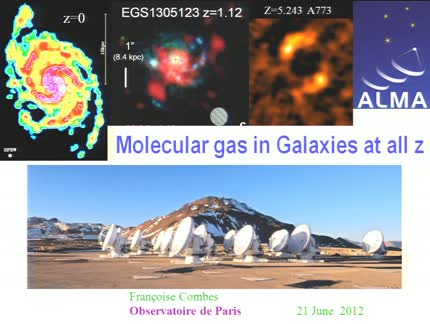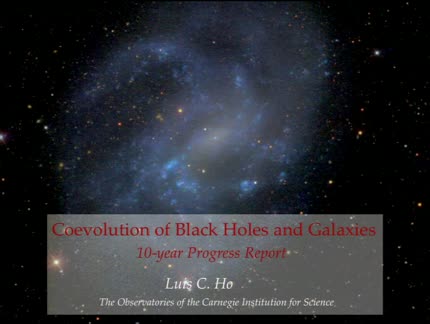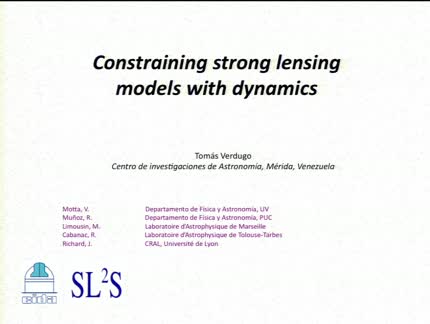Found 219 talks archived in Galaxies

Abstract
Massive early-type galaxies constitute an ideal test bed to probe our understanding of galaxy formation and evolution. Their high mass, spheroidal morphology and overly old stellar populations, along with their presence over a wide range of redshifts put to the test our current paradigm of formation via hierarchical growth. In this talk I will review recent work focused on the dark and bright sides of this problem. The former is tackled via gravitational lensing, comparing the dark matter and luminous components out to several effective radii, probing the efficiency of baryon collapse and ejection, and its feedback on the dark matter distribution (adiabatic compression). The bright side of early-type galaxies is approached via photo-spectroscopic analyses of the stellar populations, revealing a complex formation and assembly history with two well-defined phases of growth, and an intriguing connection with the "microphysics" of star formation.

Abstract
A simple model using the balance of photodissociation assuming a one-dimensional plane-parallel model yields total hydrogen volume densities for a column of atomic hydrogen under the influence of a far-ultraviolet radiation field. This can be applied wherever atomic hydrogen can be assumed to be the product of photodissociation, or perhaps where it is being kept in its atomic state because of the local radiation field. I have previously applied this model to the nearby spiral galaxies M33, M81 and M83 in the past, but the application is mostly manual and cumbersome. In order to make this method suitable to apply to larger samples of galaxies, we developed an automated procedure that identifies candidate PDRs, calculates the balance of photodissociation at locations where PDR-produced HI can be expected and provides total hydrogen volume densities. We applied the procedure to M83 as a consistency check. It is also ready to take advantage of the latest integral field spectroscopy data (metallicity), which we did in the case of M74. In principle this procedure is most suitable to probe the diffuse interstellar medium at the edges of HII regions in other galaxies than our own. However, if detailed morphological information is already available, we can improve our understanding of the method by applying it to very specific cases, such as parts of the Taurus molecular cloud. While the results are highly sensitive to the local morphology, they can potentially be used as an independent probe of the molecular gas.

Abstract
I will review some recent results about the molecular content of galaxies and its dynamics, obtained from CO lines, dense tracers (HCN,HCO+), or the dust continuum emission. New data to constrain the conversion factor XCO will be discussed. The molecular surface density is essential to determine the star formation efficiency in galaxies, and the resolved Kennicutt-Schmidt law will be presented as a function of surface density and galaxy type. Large progress has been made on galaxy at moderate and high redshifts, allowing to interprete the star formation history and star formation efficiency as a function of gas content, or galaxy evolution. In massive galaxies, the gas fraction was higher in the past, and galaxy disks were more unstable and more turbulent. ALMA observations will allow the study of more normal galaxies at high z with higher spatial resolution and sensitivity.

Abstract

Abstract
I will address the effects of bar-driven secular evolution in discs by comparing their properties in a sample of nearly 700 barred and unbarred massive galaxies. Through detailed structural decompositions I will show that, as a population, barred discs tend to have fainter central surface brightness and larger disc scale lengths than those of unbarred galaxies. Bars rarely occur in high-surface brightness discs and tend to reside in moderately blue discs. These results show that bars induce noticeable evolution in the structural properties of galaxy discs, in qualitative agreement with longstanding theoretical expectations.

Abstract
Low-luminosity AGN (LLAGN; LINERs and low-luminosity Seyferts) are present in numerous nearby galaxies and are often suggested to be the "missing link" between bright AGN and "normal", quiescent systems. Their accretion physics appear to differ from those of higher-luminosity AGN, and their place in the AGN unified scheme is not yet clear. Mid-IR observations promise new constraints on the accretion mechanisms and obscuring medium in LLAGN. However, their mid-IR emission remains almost completely unexplored at the high angular resolution needed to separate the weak nucleus from the host galaxy. I will show the results of an exploratory imaging study of ~20 LLAGN using Michelle and T-ReCS on the Gemini telescopes. Combined with Spitzer spectroscopy and high-resolution multi-wavelength information, the data establish, for the first time, the general nuclear IR properties of these objects. There are some hints that the obscuring torus disappears at low AGN luminosities, and we are also able to provide "dust-free" candidates for detailed study of the disk and jets.

Abstract
Supermassive black holes are ubiquitous in galaxies and play a fundamental role in their life cycle. I will review observational progress in defining and refining the various empirical scaling relations between black hole masses and host galaxy properties. I will emphasize ways in which the intrinsic scatter of the scaling relations can be quantified, and present evidence that the scatter correlates with physical properties. I will describe how the scaling relations can be extended to active galaxies and summarize preliminary efforts to probe the evolution of these scaling relations with redshift. I will present new measurements of the cold ISM content in AGN host galaxies and constraints they place on currently popular models of AGN feedback. Lastly, I will discuss a new class of low-mass black holes in bulgeless and dwarf galaxies that serve as local analogs of seed supermassive black holes.

Abstract
Stellar halos of galaxies offer an important laboratory to understand the galaxies’ formation process and evolution. In fact, the dynamic time scale in the halos are large, and the imprint of the formation mechanisms may still be preserved at large radii in the kinematics, in the orbital structure, in streams and substructures, or in the chemical composition and distribution of stars.
I will discuss i) the kinematic and dynamical properties of stellar halos in early type galaxies as derived from tracers like planetary nebulae and globular clusters; and ii) the stellar population properties as derived from deep long-slit spectra in a number of massive ellipticals. Results are then discussed in the framework of galaxy halo formation mechanisms.

Abstract
The mechanism by which AGN activity is triggered has long been debated. One, often suggested, method of doing so is major, gas-rich mergers and galaxy interactions. I will present deep Gemini GMOS-S images of a sample of type II quasar host galaxies, demonstrating that 75% show clear signs that they are undergoing some kind of interaction. We compare these results with a control sample of quiescent early-type galaxies and find a similar rate of interaction (68%). However, we also find that the surface brightness of the features of the type II quasars are up to 2 mags brighter than those for the control sample, suggesting a difference in the types of mergers that the two groups are undergoing. We also compare our results with those for a sample of powerful radio galaxies and find very similar values for the surface brightness of the detected features.

Abstract
Galaxy groups have an important role in the hierarchical assembly of structures in the Universe. Since galaxy groups are much more massive than galaxy-scale halos and are concentrated enough, they can act as lenses. The study of dark matter profiles can be very successfully using group-scale lenses, being that galaxy groups are quite abundant compared to galaxy clusters, and are easy to model. However, these have the disadvantage of the lack of constraints. In this talk, I will show how is possible to constrain the scale radius of the NFW profile using the velocity dispersion of the galaxy group. In particular I will present the results obtained with SL2SJ 02140-0535, a group which belongs to the Strong Lensing Legacy Survey - ARCS (SARCS) sample compiled from the final T0006 data release of the Canada-France-Hawaii Telescope Legacy Survey (CFHTLS).
Upcoming talks
- Classical Be stars - Constraining binary interaction physics in massive starsDr. Julia BodensteinerThursday April 25, 2024 - 10:30 GMT+1 (Aula)
- Runaway O and Be stars found using Gaia DR3, new stellar bow shocks and search for binariesMar Carretero CastrilloTuesday April 30, 2024 - 12:30 GMT+1 (Aula)









